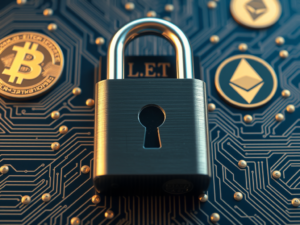Protecting Your Crypto: Best Practices Against Hacks

Security within the world of cryptocurrencies is a crucial element in protecting personal and business assets from various threats. As the cryptocurrency market grows, so does the number of attacks that can lead to significant financial losses. In this article, we will discuss the most common threats associated with cryptocurrencies and the best practices for protecting resources from hacks and frauds.
Types of Threats in Cryptocurrencies
- Exchange Hacks: Attacks on cryptocurrency exchanges are among the most common types of threats. A notable example is the incident at Coincheck in 2018, where over $500 million worth of NEM tokens were stolen. The security of exchanges depends on implementing advanced protection methods, such as storing the majority of assets in cold wallets (offline storage) and regular security audits. Ensuring a high level of security also requires the use of advanced technologies, such as multi-signature wallets and fund segregation (keeping customer funds separate from company funds).
- Phishing: This is one of the most prevalent threats in the cryptocurrency world. Fraudsters impersonate popular exchanges or cryptocurrency wallets, sending out emails leading to fake websites. The aim is to obtain private keys or login details from users. Users should be aware of such methods and learn to recognize dangerous messages by using educational resources available on cryptocurrency exchange sites and other platforms.
- Exploits in Smart Contracts: Decentralized applications (DApps) and smart contracts are often targeted due to flaws in their code. An example is the DAO attack in 2016, where a bug in the code allowed attackers to drain funds. Regular audits of code, penetration testing, and using well-established frameworks are crucial for securing such applications. Developers should follow best practices in programming, such as using security analysis tools and carefully vetting every piece of code introduced into the system.
- Ransomware: For malicious software that encrypts users’ files, requiring payment in cryptocurrencies for decryption, it is crucial to implement best practices in protecting against such threats. Regular backups and using up-to-date antivirus software can significantly reduce the risk of infection. Educating users about recognizing and avoiding suspicious websites and emails that could lead to system infections is also important.
Best Practices for Protecting Against Attacks
- Two-Factor Authentication (2FA): Adding an extra layer of security, such as SMS-based verification codes, greatly reduces the risk of account takeover by criminals. Most cryptocurrency exchanges offer this option as a way to secure user accounts.
- Cold Wallets: Storing cryptocurrencies in offline wallets (cold wallets) prevents remote attacks and hacks of exchanges. This is one of the safest methods for storing cryptocurrencies as it minimizes the risk of losing funds due to hacker attacks.
- Code Audits: Regular code audits of smart contracts before deployment are essential to identify and fix security flaws. This is a critical component in the development process of blockchain applications, which can minimize risks associated with coding errors.
- Education: Training users on recognizing threats related to cryptocurrencies is essential. Websites like Binance Square offer educational articles that help users understand what threats may await them. By educating users, it is possible to equip them with tools to effectively recognize and respond to attacks.
- Transaction Monitoring: Tools for monitoring suspicious activities on accounts and in transactions can help detect unauthorized operations and block them at an early stage. These systems are essential for managing risks in the cryptocurrency sector.
Security in cryptocurrencies is a dynamically evolving field where continuous improvement of technology and user education plays a crucial role in preventing attacks and protecting assets. Regular software updates, following best security practices, and raising awareness about threats form the foundation of a secure cryptocurrency environment.






 Bitcoin
Bitcoin  Ethereum
Ethereum  Tether
Tether  XRP
XRP  Solana
Solana  USDC
USDC  Dogecoin
Dogecoin  TRON
TRON  Lido Staked Ether
Lido Staked Ether  Cardano
Cardano  Hyperliquid
Hyperliquid  Wrapped Bitcoin
Wrapped Bitcoin  Wrapped stETH
Wrapped stETH  Sui
Sui  Chainlink
Chainlink  Bitcoin Cash
Bitcoin Cash  LEO Token
LEO Token  Avalanche
Avalanche  Stellar
Stellar  Toncoin
Toncoin  USDS
USDS  Shiba Inu
Shiba Inu  WETH
WETH  Wrapped eETH
Wrapped eETH  Hedera
Hedera  Litecoin
Litecoin  Binance Bridged USDT (BNB Smart Chain)
Binance Bridged USDT (BNB Smart Chain)  Ethena USDe
Ethena USDe  Polkadot
Polkadot  Monero
Monero  Bitget Token
Bitget Token  WhiteBIT Coin
WhiteBIT Coin  Coinbase Wrapped BTC
Coinbase Wrapped BTC  Pepe
Pepe  Uniswap
Uniswap  Aave
Aave  Pi Network
Pi Network  Dai
Dai  Ethena Staked USDe
Ethena Staked USDe  Bittensor
Bittensor  OKB
OKB  Internet Computer
Internet Computer  BlackRock USD Institutional Digital Liquidity Fund
BlackRock USD Institutional Digital Liquidity Fund  Aptos
Aptos  NEAR Protocol
NEAR Protocol  Cronos
Cronos  Ethereum Classic
Ethereum Classic  Jito Staked SOL
Jito Staked SOL  Ondo
Ondo